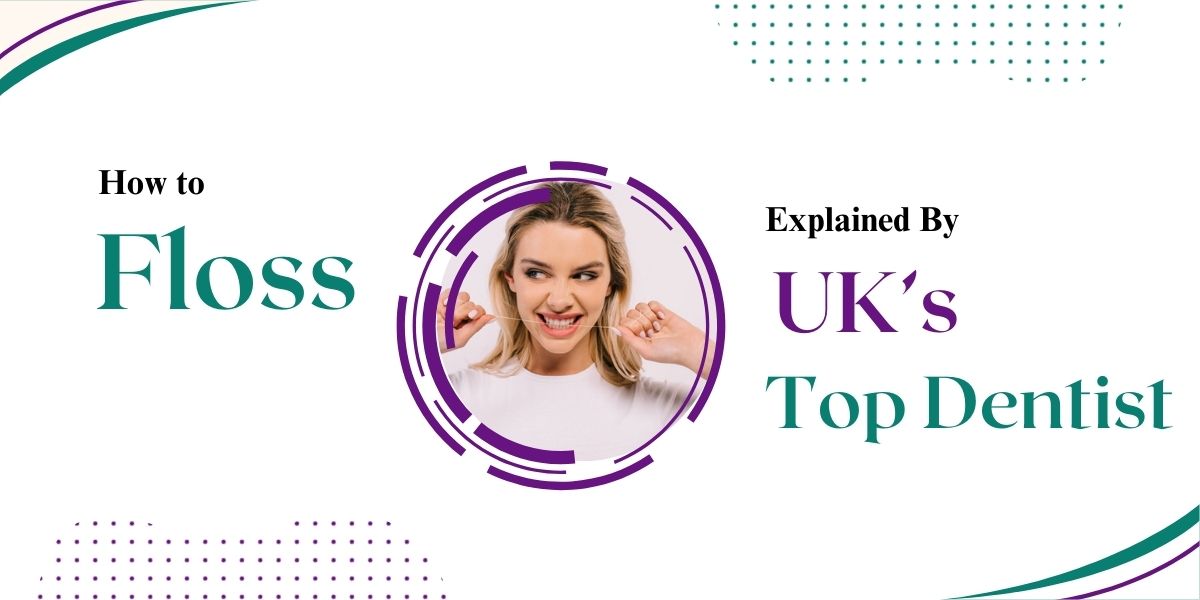
How to Floss Explained By UK’s Top Dentist
As your local Dentist Wimbledon, I always emphasize proper flossing technique at checkups. When done correctly, flossing removes harmful plaque and debris hiding between teeth and just below the gum line that your toothbrush simply cannot reach. Here is your complete guide to flawless flossing technique:
Choose the Right Floss
Pick floss that comfortably fits your mouth and teeth spacing. Traditional nylon string floss works well for most people. Waxed options glide smoothly between tight teeth while unwaxed flosses grip better around dental work. Special plastic flosses slide under bridges or orthodontics too. Consult your Wimbledon dentist about which floss type suits your unique oral situation.
Prepare a Strand
Unwind roughly 18 inches of floss from the spool, then wrap the bulk of it around one middle finger, leaving an inch or two taut between hands. This finger-wrapping allows you to firmly apply tension to the thin section you’re actively using to clean between teeth. Adjust strand length to your needs.
Ease Between Teeth
Gently guide floss between two teeth using a zigzag motion, taking care not to forcibly snap it down which can damage tender gums. Curve the floss into a C-shape hugging the edge of one tooth, then repeat against the adjacent tooth edge. Avoid sawing back and forth. Go slow until you find your technique groove.
Clean Below the Gumline
Scrub that looped section carefully below your gumline using up-down strokes, not just at the tooth’s visible crown area. This method lifts trapped bacteria and food particles from the vulnerable gum pockets and tooth root surfaces where decay and infection start. Rub firmly but be gentle on gums.
Floss All Teeth
Systematically clean between every tooth, even with no visible gap. Molars especially have concealed crannies vulnerable to plaque accumulation and inflammation when left un-flossed. Take your time and be thorough—half-hearted flossing defeats the purpose. Don’t forget the backs of your last molars!
Refresh the Strand
Unwind clean floss as existing section gets dirty. Bacteria streamers begin forming on used floss which you then risk redepositing between teeth. Avoid this by regularly exposing a new segment until the entire mouth is flossed.
Rinse Out Debris
Swish water vigorously around your mouth after flossing to clear all the gunk and detritus stirred up by the process from your gum pockets and oral surfaces. Now your teeth and gums can bathe in clean saliva instead of bacteria-rich buildup!
Look Out for Bleeding
Inflamed gums often bleed at first when flossed—further proof of how vital flossing is for them! As you continually floss, bleeding should fade within a couple weeks. If heavy or persistent bleeding occurs however, report it to your dentist Wimbledon as this indicates gum disease requiring treatment. Don’t avoid flossing altogether.
Make Flossing a Habit
To benefit your gum and dental health, floss once daily before bed when oral bacteria accumulation peaks. If once feels unachievable, begin by flossing a few days a week then build up gradually. Consistency beats sporadic bursts. Over time, flossing becomes quick second nature to your routine with gum and teeth happiness as the sweet reward!
Flossing is extremely important for oral health and providing several key benefits:
- Removes plaque between teeth that brushing misses. Up to 35% of tooth surfaces have plaque that cannot be reached by brush bristles alone. Flossing gets between teeth to clear this debris and reduce inflammation and decay risk.
- Protects from gum disease. Plaque buildup causes gingivitis which can advance to serious periodontitis gum infection and tooth loss if untreated. Flossing keeps gum pockets clean.
- Lowers risk of heart disease. Gum disease allows oral bacteria into the bloodstream which can lead to arterial inflammation raising chances of heart attack and stroke. Flossing fights gum disease.
- Prevents bad breath. Decaying food stuck between teeth ferments causing unpleasant odor released when you open your mouth. Flossing removes these rotten debris.
- Avoids tooth decay. Trapped sugary debris feeds acid-producing oral bacteria which demineralize tooth structure. Eventually this causes cavities. Flossing clears it.
If you don’t floss plaque and tartar continues accumulating between teeth, fueling escalation of dental caries and periodontal problems. Lack of flossing is a major reason for tooth loss among adults. Cavity risk soars without this daily hygiene habit.
Few factors to consider before deciding upon Invisalign clear aligners to align the teeth
Flossing is beneficial when done properly and consistently. It’s vital for supplementing your daily brushing and controlling heavy bacterial growth between teeth in those narrow spaces a brush simply cannot reach alone. Always floss gently though to avoid damaging gums.
It is never okay to floss but NOT brush your teeth too. Brushing and flossing go hand-in-hand as critical partners for thorough oral hygiene and dental health. Flossing alone merely moves debris around your mouth rather than effectively clearing it. The two activities have complementary protective actions.
Don’t hesitate to ask your SW19 Confidental Dental Clinic, Wimbledon dentist or hygienist at your next appointment for personalized pointers on flawless flossing technique. We want your gum tissue healthy and your smile vibrant! Flossing just once daily makes a meaningful difference.

